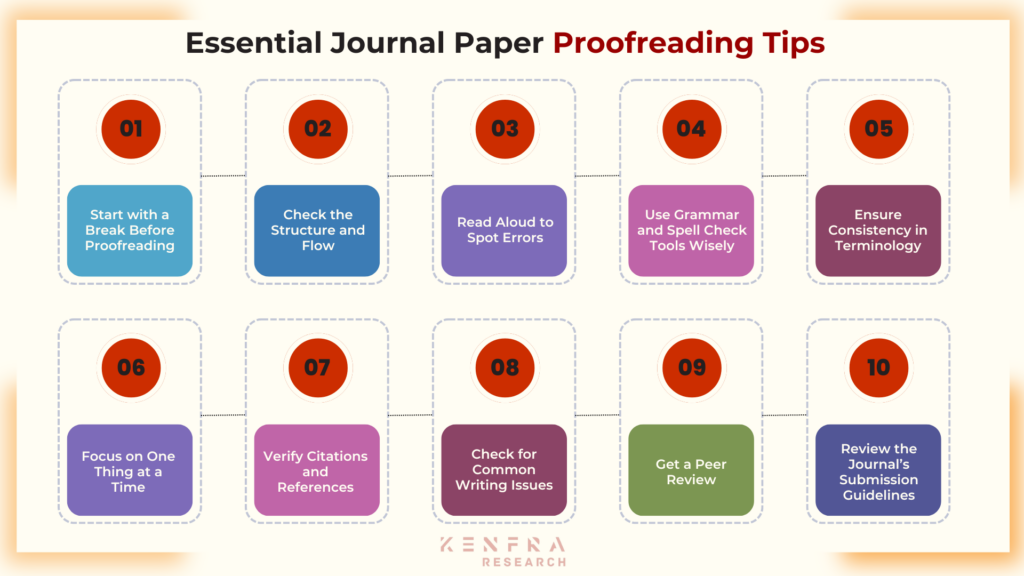11Nov
- Home
- Essential Journal Paper Proofreading Tips
- PhD Research Updates
- Essential Journal Paper Proofreading Tips

Essential Journal Paper Proofreading Tips help ensure that your journal paper is clear, error-free, and ready for submission to high-impact journals. The process not only involves fixing basic spelling and grammar mistakes but also improving clarity, structure, and coherence. This blog will provide you with essential journal paper proofreading tips to help you present your research in the best possible light.

After writing your journal paper, take a break before you start proofreading. A fresh perspective helps you spot errors you might miss when you’re too close to the material. Whether it’s a few hours or a day, stepping away from your paper allows you to return with clearer eyes.
Pro Tip:
If you’re on a tight deadline, set a timer for a 10-minute break every hour to give your mind a rest during the proofreading process.
Before diving into grammatical details, ensure that your paper flows logically and that your arguments are well-structured. Check if each section serves its purpose:
Pro Tip:
Review each paragraph to ensure it transitions smoothly into the next. Ensure that your argument develops logically throughout the paper.
Reading your journal paper aloud helps catch awkward or unclear sentences. When you read silently, your brain may overlook small errors because you already know what the text is supposed to say. Reading aloud forces you to slow down and pay attention to every word.
Pro Tip:
If possible, record yourself reading the paper and play it back. This allows you to hear your work from a different perspective.
Grammar and spell-checking tools, such as Grammarly, ProWritingAid, or Microsoft Word’s built-in spell checker, are valuable for catching simple mistakes. However, they are not foolproof, and sometimes they can miss contextual errors or suggest changes that alter your intended meaning. Always cross-check the suggestions before accepting them.
Pro Tip:
Use tools to catch basic errors, but don’t rely solely on them. They should be a first pass, not your final step.
Pro Tip:
Create a list of key terms and their definitions before writing your paper, and refer to it during the proofreading process to ensure consistency.
Proofreading for every possible error all at once can be overwhelming. To make the process more manageable, focus on one specific type of error during each round of proofreading:
Pro Tip:
Make separate passes for grammar, structure, and formatting to ensure a thorough review.
Academic papers rely heavily on accurate citations. Double-check that all in-text citations match the references in your bibliography or reference list. Ensure that the citation style required by the journal (e.g., APA, MLA, IEEE) is consistently applied.
Pro Tip:
Use reference management software (such as EndNote or Mendeley) to keep track of sources and automatically format citations.
There are several common writing issues that may not be caught by basic spell-check tools, including:
Pro Tip:
Read your paper backwards (starting from the last sentence) to help focus on individual sentences and catch overlooked issues.
Another effective proofreading tip is to have a peer or colleague review your paper. A fresh set of eyes can spot errors you might have missed, suggest improvements, and ensure your arguments are presented clearly. If possible, have someone who is familiar with your field review the technical aspects.
Pro Tip:
Provide your reviewer with a checklist of aspects you’d like them to focus on, such as clarity of argument, structure, and terminology.
Different journals have specific formatting and submission guidelines. Make sure you’ve adhered to the journal’s requirements for things like:
Pro Tip:
Before submission, double-check the journal’s “For Authors” section to ensure that your paper meets all their requirements.
Proofreading your journal paper is not just about fixing typos; it’s about ensuring that your work is clear, consistent, and polished. By following these essential journal paper proofreading tips, you can improve the quality of your manuscript and increase your chances of acceptance. Remember, thorough proofreading enhances the readability and professionalism of your work, ensuring it makes a strong impression on reviewers and editors.
Proofreading may take time, but it’s an investment that can make the difference between a paper that’s rejected and one that’s accepted for publication. So, take the time to proofread thoroughly and give your research the attention it deserves.
Get Flawless essential journal paper proofreading tips and Services from Kenfra Research
Need more support on your PhD journey? Kenfra Research is here to guide you through every step, from topic selection to final thesis submission!

ABDC Journal List 2024 | Comprehensive Guide by Kenfra Research read more

If you're launching a website, one of the most crucial decisions you'll make is choosing the right web hosting. Web... read more

A PhD interview is a critical step in securing your place in a doctoral program. Your PhD Interview allows... read more
WhatsApp us
Leave a Reply